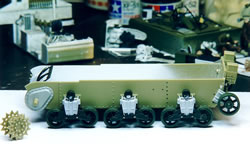| Building
Tamiya's M3 Lee |
 |
The Suspension and TracksThe Tamiya kit has six-spoked wheels (they should be five-spoked instead), and the bogies have solid arm braces that angle up to the mounting plate. Consequently, the front faces of the bogies are a bit taller than they should be. I purchased Tiger Model Designs' replacement M3 suspension units. I had planned on using Italeri's rubber band track from the M4A1, but when I saw how fragile and fiddly the TMD set was, I knew the tight rubber band would play havoc with the completed suspensions. Unfortunately, the TMD set needs quite a bit of cleanup, especially the spoked wheels. It's difficult to tell where some of the pieces end and the resin carriers begin. And even though I assembled the bogies according to the instructions, there's a protrusion on the mounting plate that keeps it from mating flush with the back of the bogie. I figured that was some sort of design feature. However, it appears to be a design flaw. When it came time to dry fit the TMD suspensions, I discovered that they splayed outward at the bottom when placed onto the hull, because of the offending protrusion on the TMD mounting plate. Between this problem and the cleaning and some off-kilter rollers, I had maximized my frustration quota. Rather than disassembling and rebuilding them, I bagged them for a future project and took a fresh look at the Tamiya suspension.
Now, the TMD suspension requires that you shave the mounting plates off the Tamiya hull. I had done this with a chisel-tipped X-acto, carefully avoiding the adjacent rivets. (This actually became a welcome diversion from cleaning up the TMD parts, and vice versa.) However, since I'd carved off the mounts on the Lee hull to accept the TMD bogies, I now either needed to build new mounts or buy myself a new hull. The Tamiya Grant provided salvation in two ways: not just a new hull, but correct air cleaners for the version I was building. After the bogie units were attached to the new hull I noticed that the rear wheel on each unit is raised off the surface by about 1/8"-and it's the same on the original kit my son and I built years ago. It's nothing that is clearly noticeable with the tracks on and the tank sitting on an uneven surface, such as the Moroccan desert. But it seems to be another flaw in the design of the Tamiya suspension. I did not like the thin transmission end covers molded onto the Tamiya hull and pulled some spare covers from a DML Sherman. I figured it would be best to preserve the original axles because I planned to use the kit's sprockets, and didn't think replacement axle pieces would be strong enough for the tension of rubber band tracks. So I carved off the kit's transmission covers from the new hull, preserving the original axles. I then took the DML covers, removed the integral axles, and drilled out the remaining plastic so the covers could slide down over the kit's axle, and glued the covers in place. Very clever, I thought at the time. The rear idler mounts on the Tamiya hull are devoid of detail, and the wedge-like mounting plates are wrong. So I carved off the plates. I had purchased new plates and idler mounts from Paul Roberts, which are just resin castings of Italeri M4A1parts. However, for reasons that will become clear below, I opted for spare plastic pieces from one of my DML kits. When I opted for the TMD suspension I figured they would never stand the stress of the unforgiving rubber bands, so I bought a set of AFV Club T-51 links. Unfortunately, they are too large for the Tamiya sprockets: they are a touch wider so they don't nestle into the crotches of the sprocket, and are also a bit wide between the sprockets. Shaving down the guides could solve the latter problem, but I had no good solution for the spacing problem. So I ditched the indy links-after having cleaned them all up-and returned to the Italeri tracks. And this meant using the plastic rear idler pieces, which I felt would glue more securely and hold up to the potential stress of the rubber bands better than supergluing Paul's resin pieces. Here are a couple of hints for those old inflexible M4A1 tracks. Make sure the individual treads are not fused together; you should be able to see some daylight between the treads, or at least some break between them. Use your hobby knife to carefully separate just the treads. That will improve the flexibility somewhat. After joining the track ends together, I dropped the tracks into some boiling water for a few seconds. That softened them up nicely and then I slipped them over the assembled suspension of my old Lee. I wedged some cardboard between the sponsons and the tracks to create some pressure and get the rubber bands to mold over the rollers and give just a hint of weight between the rollers. The tracks cooled and kept their shape, and I could paint them separately after removing them from the old hull. Be
careful not to install and remove the looped bands too often around
the suspension because the method of attaching the track ends with
a hot screwdriver doesn't make for the strongest bond. The ejector
pin marks in the treads are not easily removed and are annoying,
so I'll probably swap these out with something better in the future. Introduction
and Research Notes
|
 |
 |
 |
 |
 |
 |
 |
 |
 |
 |
 |
 |
|
